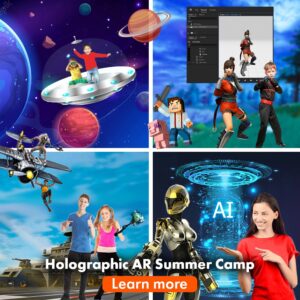
As a school administrator, you always try to match your purchases to your vision and your goals for your students. In addition, you want teachers on multiple grade levels and subject areas to use a new resource, impacting as many students as possible. Integem’s exciting Holographic AR STEAM Program is an innovative set of lessons and materials that raise the level of thinking and problem-solving in all elementary classrooms. Science, Technology, Art, and Mathematics are all required by the state standards. Using the principles of Engineering connects those subjects in ways that makes learning relevant and exciting.
STEAM activities are not worksheet based. They are project oriented and focus on collaboration, building academic and social skills simultaneously. Recent research has shown a correlation between STEM Activities and the reduction of Math Anxiety in children (Mitchell, 2018).
Class time is limited. Teachers want to find resources that cover multiple standards and concepts simultaneously. In addition, they want to keep students interested and engaged. STEAM activities provide the motivation for students to stay engaged as well as the complexity needed to build children’s reasoning and decision-making ability. Academic studies have noted the value of using STEM activities to make their math, science, and computer science (technology) standards more relevant ( (Hoachlander, December 2014/January 2015; Jamalian, 2018).
Why AR?
STEAM programs are already collaborative and teach math, science, art, and technology standards. Augmented Reality (AR) takes STEAM into the future, both literally and figuratively. Integem’s Holoraphic AR STEAM program is different because it allows students to interact with three dimensional images in ways that they may not be able to experience in a real classroom. They can perform science experiments that might be impossible, dangerous, or too expensive to conduct in a science lab. For example, (Fleck & Simon, 2013) recommended Augmented Reality to teach Astronomy so that student could scaffold their understanding from the concrete to the abstract because of the immersive visual experience. “Because the AR model enhances sensory motor interactions, visual guides and realistic representations, pupils benefit from a reduced complexity to construct a scientific comprehension of phenomena” (p. 14).
Integem’s Holographic AR STEAM program is a beneficial addition to any classroom because it doesn’t just let students use Augmented Reality. The students create it themselves, putting an image of themselves into the virtual environment and manipulating it to interact with what they see around them. A blended learning environment of physical and digital images helps a child’s brain understand and transfer knowledge into different parts of the brain more quickly that using books or worksheets alone. Weng, Bee, Yew, & Hsia (2016) concluded that “AR allows the learners to promote reflection of the metacognitive processes, through “transfer” of learning (p. 12).
Our AR Holographic Program has creative lessons with all the materials and support that teachers need, regardless of their students’ ages, grade levels, or content areas. Science, Technology, English, and Mathematics are all required state curriculums. In addition, Art is another of the elementary content areas. When Art is added to STEM, a new acronym, STEAM, is created. Engineering continues to tie all the content areas together. Including Art as a part of the process of thinking makes integrated learning even more engaging and inclusive for students with different learning preferences (Graham & Brouillette, 2016).
One resource.
All the standards.
The Integem Holographic AR Technology Program covers ALL the objectives of the state Computer Science standards in grades K-12. In addition, it has science, art, and math content integrated into its lessons so that teachers can use the scope and sequence chart to save instructional time, increase the likelihood of student success, and simultaneously cover the standards of multiple content areas. It can revolutionize the learning experience.
In addition, the collaboration necessary to problem solve in a small group setting increases the opportunity for students to practice different types of social skills such as listening and following directions, interpersonal skills, and problem-solving skills like asking for help and deciding what to do, (Social Skills: Promoting Positive Behavior, Academic Success, and School Safety, 2002).
It is time for a paradigm shift in the use of technology in a classroom. Instead of using a program to complete a task, Integem Holographic AR Technology requires students to use critical thinking, collaboration, and problem-solving to create a project that puts the student into a virtual world that they can design and explore. The projects they build are individual and creative but focus on the standards that they need to learn in Science, Technology, Math, English, and Art by using the principles of Engineering.
For years, educators have touted the importance of developing executive function to solve problems. Your teachers know that, but how are they developing it? When you walk through your elementary classrooms, do you see activities that develop executive function and critical thinking skills? One researcher explained that executive function has several components, citing several studies which concluded that working memory and inhibitory control are better predictors of math and reading competency than IQ scores (Diamond, 2016). Integem’s AR Holographic Program helps student develop their executive function through individual and group decision-making and problem-solving.
Reflect on what best teaching practices and technology resources your school is using. What curriculum are you using to address your campus and district technology goals? Is it integrated into other content areas, or is it another “stand alone” curriculum? Our program is rigorous enough to enrich classroom instruction and adaptive to use in either after school programs or summer “camps”. It can remediate concepts students didn’t understand with traditional instruction or extend the students’ creativity by letting them invent new ways to explore the world by putting themselves into holographic environments.
Integem Holographic AR Technology can not only address academic goals, but it can directly impact your Continuous Improvement Plan as a strategy that improves student attendance and reduces the number of suspensions that occur each year. How can we claim to help your students in those non-academic areas? Engagement is key to attendance in elementary schools for students in all demographics (Brouillette, Childress-Evans, Higna, & Farkas, 2014). We believe that our technology is so revolutionary that students will want to come to school, participate in building virtual worlds where they immerse themselves into the narrative, and learn how to collaborate, problem-solve, and learn without being frustrated by traditional school models that expect all children to learn the same way and do the same thing. Integem helps your students develop relationships with other students as well as the teacher, increasing student engagement in the classroom . (Conner, 2016) concluded that:
Without engagement, students tend to not only withdraw emotionally and cognitively from the learning process, but also physically take themselves away from the school setting altogether. The costs for this withdrawal are considerably high for both the student and society in many forms, including the lack of productive citizenship.
Developing relationships is key to reducing behavior problems in your school (Payne & Tucker, 2017). Integem’s AR Holographic Program provides a great opportunity for students to develop relationships and positively interact with the teacher and other students. The Artificial Reality Holographic STEAM Program lets the students build themselves into a program and share their stories with others in a supportive, positive environment that builds trust and self-efficacy.
In addition to engagement and building relationships, some studies have pointed to the use of AR technology for building empathy in children. Carolan (2018) explained that all technology, from the Gutenberg printing press to Artificial Reality gives people the opportunity to see things from different perspectives. “Those who read more literary fiction are better at detecting and understanding other’s emotions.” In a similar manner, students can explore other worlds through Artifical Reality and build empathy for others as they expand their own knowledge and experiences.
Funding
When looking at technology funding sources, consider different special population budgets in addition to your general campus supply and curriculum budgets. Integem’s Holographic AR Technology fits the needs of specific groups in new and exciting ways.
Gifted Education is an area that is seldom adequately addressed in schools. Integem’s Holographic AR Technology allows the most creative of students to design things “their way”. Students do not all build the same program. Each child’s project is unique while they learn together a science standard that is required of all students. The way they manipulate the program and put themselves into it is different from anything else you have ever seen. Explore more about these activities here: https://integem.com/courses
English Language Learners benefit greatly from visual models as well as group projects that encourage oral language communication. As ELL students progress through the stages of speaking, reading, and then writing in a new language, Integem provides the imagery and content they can use to learn scientific terms, technology objectives, and improve their language skills when they collaborate with other students. Learn more about our many different lessons about 2D and 3D technology here: https://creator.integem.com/
Title 1 schools often provide after-school or summer enrichment programs for their students. Integem has programs specifically designed to fit these classes in two-week “camps”. This use of our curriculum is perfect for Title 1 funding because it supports science, language arts, and mathematics instruction while providing enrichment through technology education. Students will love this new way to explore concepts such as space, nature, and digital art. It even has a News Reporter unit that incorporates Reading and Language Arts, which are a perfect fit for the requirements of Title I instructional activities. See the courses we offer for schools at these links:
Junior Space Voyagers: https://www.integem.com/course?id=S01
News Reporter: https://www.integem.com/course?id=R01
Junior Digital Artist: https://www.integem.com/course?id=A01
Young Space Voyagers: https://www.integem.com/course?id=S02
Young Nature Explorer: https://www.integem.com/course?id=N02
Young Digital Artist: https://www.integem.com/course?id=D02
Young Engineering Innovator: https://www.integem.com/course?id=H02
Professional Development
We want your teachers to be our partners in bringing the Holographic Technology experience alive. The key to successfully implementing a new technology program is quality teacher training (Hew & Brush, 2007). We offer both in-person and online training, as well as a continuous learning program to keep teachers updated on the latest uses of our technology. We will even come into your school and teach a class, modeling good instructional practices to show teachers how to use our program. In addition, we provide comprehensive lesson plans and detailed instructional materials for teachers to confidently use in the classroom, their summer enrichment camp, or in an after-school program.
Contact us at support@integem.com, or call us at +1-408-459-0657. We are eager to help you revolutionize instruction in your school.
References
Brouillette, L., Childress-Evans, K., Higna, B., & Farkas, G. (2014). Increasing engagement and oral language skills of ELLs through the arts in the primary grades. Journal for Learning through the Arts, 10(1). doi:10.21977/D910119300
Carolan, J. (2018, April 22). Empathy technologies like VR, AR and social media can transform education. Retrieved from TechCrunch: https://techcrunch.com/2018/04/22/empathy-technologies-like-vr-ar-and-social-media-can-transform-education/
Conner, T. (2016). Relationships: The key to student engagement. International Journal of Education and Learning, 5(1), 13-22. doi:10.14257/ijel.2016.5.1.02
Diamond, A. (2016). Why improving and assessing executive functions early in life is critical. In J. A. Griffin, P. McCardle, & L. S. Fruend (Eds.), Executive Function in Preschool-Age Children: Integrating measurement, neurodevelopment, and translational research (p. 12). American Psychological Association. doi:10.1037 /l 4 797.002
Fleck, S., & Simon, G. (2013). An augmented reality environment for Astromony learning in elementary grades: An exploratory study. Proceedings of the 25th Conference on I’International Homme-Machine (p. 14). ACM.
Graham, N. J., & Brouillette, L. (2016). Using art integration to make science learning memorable in the upper elementary grades: A quasi-experimental study. Journal for Learning Through the Arts. doi:10.21977/D912133442
Hew, K. F., & Brush, T. (2007, June). Integrating technology into K-12 teaching and learning: Current knowledge gaps and recommendation for future research. Educational Technology Research and Development, 55(3), 223-252. doi:10.1007/s11423-006-9022-5
Hoachlander, G. (December 2014/January 2015). Integrating SET&M. Educational Leadership, 74-78.
Jamalian, A. (2018, June 13). How to start and scale a successful STEM program. littleBits Education. Retrieved from https://www.eschoolnews.com/files/2018/06/STEMProgramWhitepaper-v2.pdf
Mitchell, K. M. (2018, October). Best practices to reduce math anxiety. Pepperdine University, Graduate School of Education and Psychology. Ann Arbor: ProQuest. Retrieved from https://search.proquest.com/docview/2130172902
Payne, R., & Tucker, B. H. (2017). Research Based Strategies: Narrowing the Achievement Gap for Under Resourced Students- Revised Edition. Highlands, TX: aha! Process.
Social Skills: Promoting Positive Behavior, Academic Success, and School Safety. (2002). Retrieved from NASP Center: https://www.naspcenter.org/factsheets/socialskills_fs.html
Solak, E., & Cakik, R. (2015). Exploring the effect of materials designed with Augmented Reality on Language Learners’ vocabulary learning. Journal of Educators Online, 12(2), 50-72. Retrieved from https://files.eric.ed.gov/fulltext/EJ1068381.pdf
Weng, N. G., Bee, O. Y., Yew, L. H., & Hsia, T. E. (2016). An augmented reality system for Biology science education in Malaysia. International Journal of Innovative Computing, 6(2), 8-13.



Recent Comments